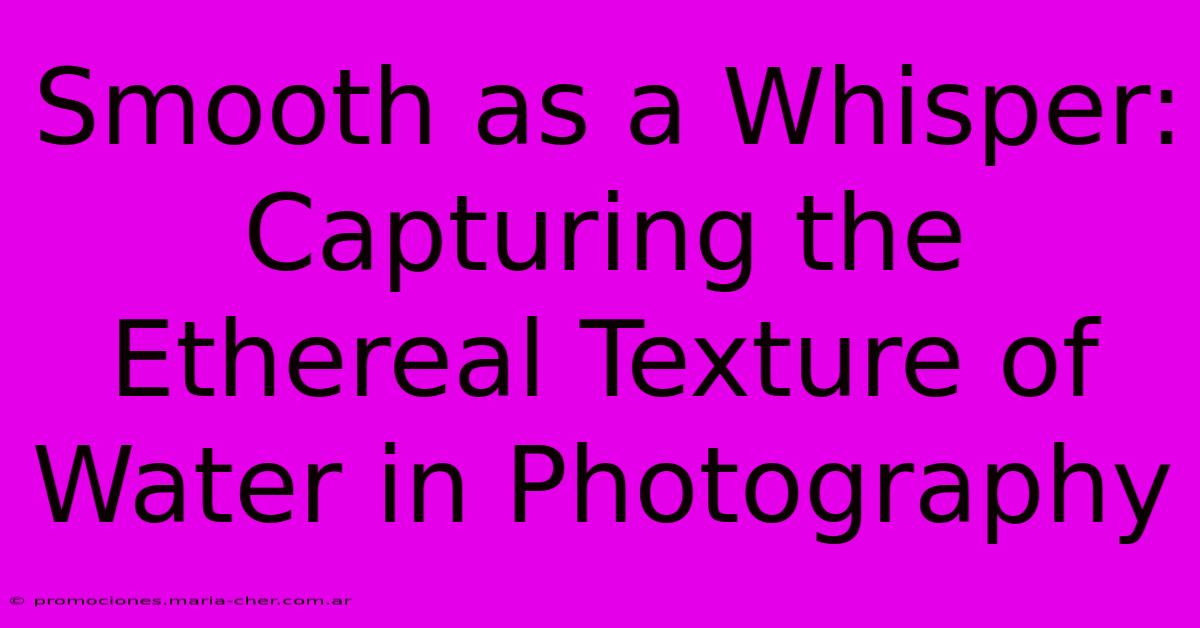Smooth As A Whisper: Capturing The Ethereal Texture Of Water In Photography

Table of Contents
Smooth as a Whisper: Capturing the Ethereal Texture of Water in Photography
Water. It's a photographer's dream, a constantly shifting canvas of light, reflection, and movement. But capturing the ethereal texture of water – that silky smoothness, that glassy stillness, or the energetic rush of a waterfall – requires more than just pointing and shooting. This article dives into the techniques you need to master to photograph water with stunning, whisper-quiet beauty.
Understanding the Nature of Water in Photography
Before you even pick up your camera, it's crucial to understand how water behaves in front of the lens. Water's texture is dictated by several factors:
- Speed: Fast-moving water (like a raging river) appears blurred and ethereal when photographed with a slow shutter speed. Conversely, a slow shutter speed on still water creates a mirror-like reflection.
- Light: The angle and intensity of the light dramatically impact the appearance of water. Backlighting can highlight its texture and create dazzling reflections, while harsh midday sun can wash out detail.
- Composition: The surrounding environment plays a vital role. A tranquil pond surrounded by lush greenery will evoke a different feeling than a crashing ocean wave against a rocky shore.
Essential Gear for Water Photography
While you can capture stunning water photos with basic equipment, the right gear can significantly elevate your results:
- Camera: A DSLR or mirrorless camera with manual controls is essential for precise exposure adjustments.
- Lenses: A wide-angle lens is ideal for capturing expansive landscapes, while a telephoto lens allows you to isolate details and compress perspective. Consider a polarizing filter to reduce glare and enhance color saturation. A Neutral Density (ND) filter is crucial for achieving longer exposures in bright conditions.
- Tripod: Absolutely essential for sharp images, especially during long exposures. A sturdy tripod ensures stability, preventing camera shake.
- Remote Shutter Release: Minimizes camera shake during long exposures, leading to sharper images.
Mastering the Techniques: Long Exposure Photography
Long exposure photography is the cornerstone of capturing the smooth, dreamlike texture of water. Here's how to master it:
Choosing the Right Shutter Speed:
The ideal shutter speed depends on the water's movement:
- Still Water: Start with shutter speeds ranging from 1-30 seconds to create a mirror-like effect.
- Moving Water: For a silky smooth effect, use shutter speeds of 1/2 to several seconds. Experiment to find the sweet spot.
- Waterfalls and Rapids: Shutter speeds of less than 1/2 second will create beautiful motion blur.
ND Filters: Your Secret Weapon:
In bright daylight, you'll need a Neutral Density (ND) filter to achieve the slow shutter speeds necessary for smooth water photography. ND filters reduce the amount of light entering the lens, allowing for longer exposures even in bright sunlight.
Aperture and ISO:
- Aperture: Choose a relatively narrow aperture (f/8 to f/16) to maintain sharpness from front to back.
- ISO: Keep your ISO as low as possible (ISO 100 or 200) to minimize noise and maintain image quality.
Composition and Creative Approaches
- Leading Lines: Use natural elements like rocks, shorelines, or riverbanks to lead the viewer's eye into the scene.
- Rule of Thirds: Place key elements off-center to create a more visually appealing composition.
- Symmetry and Reflections: Look for opportunities to capture symmetrical reflections in calm water.
- Silhouettes: Use backlighting to create dramatic silhouettes of trees, rocks, or other objects against the water.
Post-Processing Your Masterpieces
While in-camera techniques are crucial, post-processing can further enhance your water photographs:
- Fine-tuning Exposure and Contrast: Adjust brightness, contrast, and highlights/shadows to optimize the image's dynamic range.
- Color Grading: Subtle color adjustments can amplify the mood and atmosphere of your photograph.
- Sharpening: Carefully sharpen your images to enhance detail without introducing artifacts.
Conclusion: Embrace the Serenity
Capturing the ethereal texture of water in photography is a rewarding journey. By understanding the principles of long exposure photography, utilizing the right gear, and mastering composition techniques, you can create breathtaking images that capture the serenity and beauty of moving water. So grab your camera, head out to your favorite watery location, and start experimenting! Remember patience is key, and the rewards are well worth the effort. Happy shooting!

Thank you for visiting our website wich cover about Smooth As A Whisper: Capturing The Ethereal Texture Of Water In Photography. We hope the information provided has been useful to you. Feel free to contact us if you have any questions or need further assistance. See you next time and dont miss to bookmark.
Featured Posts
-
Unlock The Secrets Of Streaming Apps The Ultimate Guide For Educators
Feb 07, 2025
-
The Psychology Of Selling Why We Overvalue Our Possessions
Feb 07, 2025
-
Experience Typeface Supremacy Download The Futura Now Trial Today
Feb 07, 2025
-
Transform Your Emails With Transition Images The Secret To Eye Catching Signatures
Feb 07, 2025
-
The Internets Oasis Where All Your Cravings Converge
Feb 07, 2025
